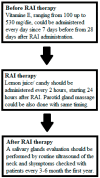The Impact of Radioiodine (131I) Therapy of Thyroid Disease on Salivary Glands Function and Inflammation: A Comprehensive Review
- PMID: 40564122
- PMCID: PMC12190391
- DOI: 10.3390/biomedicines13061404
The Impact of Radioiodine (131I) Therapy of Thyroid Disease on Salivary Glands Function and Inflammation: A Comprehensive Review
Abstract
Radioactive iodine therapy has been a well-established treatment for various thyroid conditions since the 1940s, targeting both benign diseases and malignancies. Treatment for benign conditions typically involves low doses of 131I, often requiring no more than two treatments, with the dose either fixed or personalized based on thyroid tissue mass and iodine uptake. In contrast, differentiated thyroid cancer treatment often requires higher doses and multiple administrations, especially for metastatic cases. Recent guidelines and studies have proposed more conservative management strategies, including careful follow-up, due to concerns over the high risk-benefit ratio in selected cases with a low risk of disease recrudescence. Despite its possible efficacy, radioiodine therapy is associated with dose-dependent side effects, the most common of which is salivary gland dysfunction or inflammation, affecting approximately 30% of adult patients. These effects pose significant challenges in nuclear medicine practice. This review aims to summarize the latest evidence on the incidence, impact on quality of life, prevention strategies and the role of these side effects in the decision-making process regarding RAI therapy.
Keywords: radioiodine; salivary glands; sialadenitis; side effects; thyroid cancer; xerostomy.
Conflict of interest statement
The authors declare no conflicts of interest.
Figures

References
-
- Bernard D., Desruet M.D., Wolf M., Roux J., Boin C., Mazet R., Gallazzini C., Calizzano A., Vuillez J.P., Allenet B., et al. Radioiodine therapy in benign thyroid disorders. Evaluation of French nuclear medicine practices. Ann. Endocrinol. 2014;75:241–246. doi: 10.1016/j.ando.2014.07.863. - DOI - PubMed
Publication types
LinkOut - more resources
Full Text Sources

